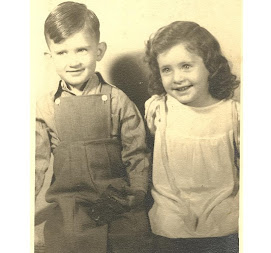I remember spending a lot of my young life in the back seat of various automobiles, going to and from various places in the west. No freeways. In fact, most of our travel was on two-lane roads that followed the contour of the landscape. Mostly I remember our old 49 Hudson Commodore, black with gray fabric
upholstery.
The landscapes tended to be bleak, desert or mountains, brown, tan, red, ocher -- any color but green. Occasionally, though, we'd pass fields of corn or alfalfa, and I'd watch the long rows march in long strides alongside our car. Sometimes, I'd put my hand out the window and observe what happened as I turned it in the airstream. Early lessons in aerodynamics.
Mom was our tour guide and entertainment center, as I don't recall ever listening to the radio. If we were passing a cemetery, she'd say, "A silent city," and make us be quiet until we'd passed it. If we were passing rugged terrain, say, in Arizona, she'd point to it and say, "Cochise's stronghold." Cochise, of course, was the legendary Apache chief. I remember thinking that Cochise sure had a lot of strongholds.
Two staples of travel back then were the billboards. There weren't many. The best of them were the
Burmashave boards. They were small, maybe three feet by two feet, and came in a sequence. There would be five. The first four would give a little verse, and the last would say
Burmashave. I liked those. You had to wait for each line of the verse to appear, but you always knew what the last one said.
There was another kind of billboard too. It would say something like, "
Maguire Caverns 200 miles" in large letters. Underneath would be a list of the delights that could be found at the caverns, usually including a zoo. In another 50 miles,
there'd be a "
Maguire Caverns 150 miles" sign. By the time we finally reached
Maguire Caverns,
Tootie and I were frantic to stop, and had pestered Mom and Dad into stopping.
Maguire Caverns, or whatever it was, was always somewhat of a disappointment. The "zoo" consisted usually of a mangy coyote and a lizard or two, and the "Caverns" would be a small cave with a store that hawked really really cheap
souvenirs. I could usually wheedle Mom and Dad into buying a rubber knife or something else to torment
Tootie with.
Oh, and we usually travelled about 55 mph the whole time.
Did I mention that the car was black, no air conditioning,
and that it was invariably hot?





